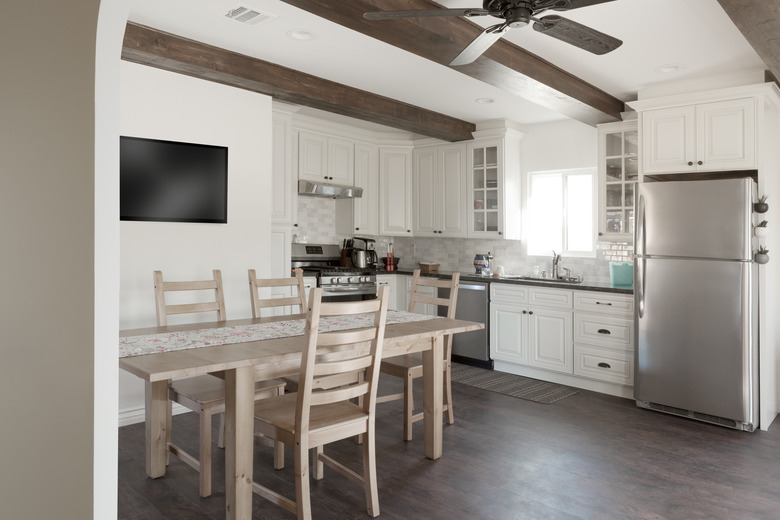The Maximum Weight For Overhead Kitchen Cabinets
Standard kitchen fare — dishes, cups, saucers, pots, pans — won't typically come close to exceeding upper kitchen cabinet weight limits, as long as variables such as cabinet hanging screws meet standards. The Kitchen Cabinet Manufacturers Association, in cooperation with the American National Standards Institute, has set voluntary weight-limit standards for cabinets. The stamp of approval is awarded to cabinets when they show no sign of visible failure at 600 pounds.
Kitchen Cabinet Weight Standards
Kitchen Cabinet Weight Standards
AWA Kitchen Cabinets notes that most manufacturers of kitchen cabinets voluntarily set their own standards and guarantees for cabinet weight capacity at not exceeding 500 pounds. Custom builders don't typically list cabinet ratings, but the integrity of almost any custom cabinet usually exceeds standards.
Kitchen Cabinet Weight Variables
Kitchen Cabinet Weight Variables
Weight calculations for cabinets are too random for a code weight limit covering all cabinets. Variables such as cabinet material, construction and design, fasteners, cabinet hanging screws, supports, studs and joists are also part of the equation.
Kitchen Cabinet Material Choices
Kitchen Cabinet Material Choices
The KCMA weight standard is based on 3/4-inch-thick structural and shelf material. Modular or box cabinets, or cabinets in recreational vehicles or mobile homes, may include thinner materials ranging from 1/4 to 5/8 inch thick, which drops weight capacity significantly.
Plywood vs. Particleboard
Plywood vs. Particleboard
Kitchen upper cabinets are typically 12 inches deep. The strength differences between particleboard and plywood at this narrow width are insignificant. Plywood holds screws and fasteners better than particleboard, however.
Adjustable Shelves for Kitchen Cabinets
Adjustable Shelves for Kitchen Cabinets
Adjustable shelving is found on kitchen cabinets all over the country. Adjustable shelves utilize four shelf clips or pegs, for each individual shelf. The weight rating for metal clips is about 25 pounds for each clip, and 10 pounds for plastic clips.
The average adjustable shelf, when equipped with metal clips, is rated at 100 pounds. Shelves with plastic clips are rated at no more than 40 pounds.
Cabinet Hanging Screws
Cabinet Hanging Screws
The integrity of any overhead cabinet installation focuses on the fasteners. The typical overhead cabinet is installed with 3-inch, No. 10, coarse-threaded screws, with a weight capacity of 75 pounds each.
Kitchen Cabinet Screw Strength
Kitchen Cabinet Screw Strength
Upper cabinets should have a minimum of at least four screws, each penetrating into separate studs. If that's not possible, two screws for kitchen wall cabinets, each into two studs is acceptable, with studs spaced the maximum distance apart horizontally, depending on the length of the cabinet. The combined weight capacity of the screws — at 75 pounds each — is about 300 pounds for a small cabinet with four screws.
Strength in Numbers
Strength in Numbers
Cabinet installers typically double or triple the screw requirement with screws penetrating through a one-by-four at the the top, and at least two additional screws through the 1/4-inch hardboard back of the cabinet. When the cabinets fit flush with the ceiling or soffit, another four to six screws penetrate through the top of the cabinet.
Studs and Joists
Studs and Joists
The weight rating of any cabinet is superseded by what it's attached to; cabinets won't stay put if they're not anchored properly. Overhead cabinet weight relies on studs and ceiling joists, which typically have ratings that exceed cabinet weight capacity.
Overhead Peninsula Cabinets
Overhead Peninsula Cabinets
Weight capacity for overhead peninsula cabinets is one of the most important considerations. Depending on layout and design, two-by-four blocking is typically required in the ceiling or soffit, specifically placed for hanging peninsula cabinets. At least six or eight screws into four or more ceiling joists is required. Blocking adds the necessary options for extra screws.
Drywall anchors, molly bolts or other inserts should be avoided when hanging cabinets.
Inspect and Fill
Inspect and Fill
Don't be concerned about stuffing your cabinets full of housewares. If you're filling them with coins, books, weights, metal objects or anything other than housewares, inspect them first.
Check for material thickness, warping of shelves or insufficient shelf clips. Check for cracks in the joinery or separations between the walls and ceiling. Look for loose or stripped screws. If everything passes inspection, your cabinets should hold up fine.
